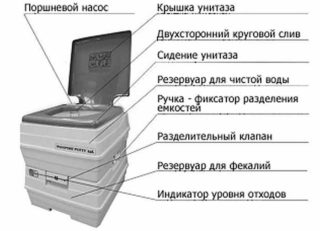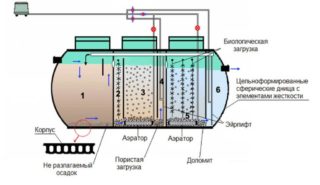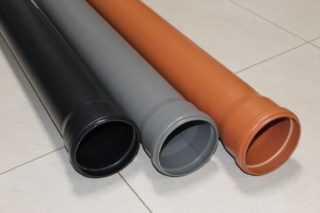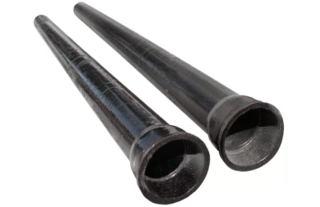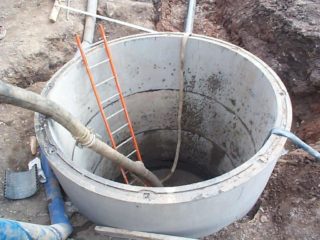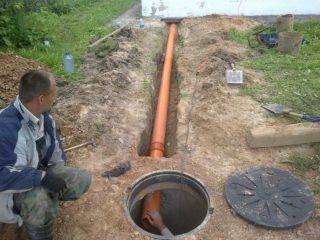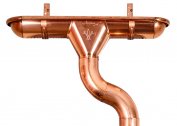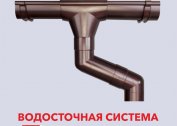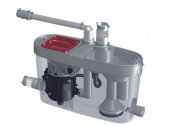The simplest sewage system in the country with your own hands will significantly improve the living conditions of the owners with a minimum of invested funds. Technological nuances are hidden in the apparent simplicity of the problem, which will help a novice plumber to better equip a suburban life.
Types and device of sewerage for a summer residence
Classification of the main types of devices in rural areas:
- dry closet;
- cesspool with a dug barrel;
- storage device;
- septic tank;
- biological station.
Having installed a dry closet, the owner is faced with the problem of water disposal from other plumbing: shower, sink and washbasin. A characteristic unpleasant odor is always present in such devices.
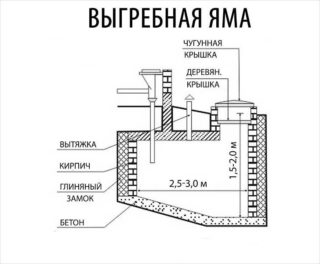 Cesspools are used quite often. Their advantage is low cost, but a number of disadvantages overlap with visible convenience:
Cesspools are used quite often. Their advantage is low cost, but a number of disadvantages overlap with visible convenience:
- possible overflow with the need for pumping;
- smell of sewage;
- pollution of the territory.
If there is no water supply system in the country, the volume of the pit will be enough for a long time. Restrictions on the use of cesspools are imposed for areas with a high level of groundwater and clay soils.
The storage tank is one of the modern options for cesspools. Their advantages are tightness, due to which the garden plot is not polluted, and the possibility of installing containers of different volumes. Wastewater storage can be mounted both on the surface of the earth and underground. Storm sewage can be connected to the tank. Cons: the need for frequent pumping of sewage and the presence of smell.
Natural wastewater treatment with a septic tank
The device consists of several compartments. With an increase in their number, the quality of purified water increases. The cleaning method using a septic tank has several advantages:
- simplicity of construction;
- low cost;
- does not require electricity;
- does not pollute the soil;
- no unpleasant odor;
- ready-made designs are available.
Once a year, according to the results of an external examination, it is recommended to clean the drainage system and the compartments of the septic tank.
Biochemical treatment
Biological treatment complexes have a high cost, but they allow disinfecting effluents up to 98%. Device Advantage:
- long term of operation up to 50 years;
- minimum maintenance.
The number of people living in the house affects the choice of a local biological treatment device. It is recommended to choose a power with a small margin, since the duration of operation implies a constant change in the number of people. To determine the level of the tie-in to the station, you must know the height of the collector leaving the house. The tie-in level is projected at 60 cm, 90 cm and 120 cm. The discharge point affects the choice of a forced or gravity drainage system.
Actual requirements for the placement of sewage on the site
 The laying of an autonomous sewer system on your own site is possible only with the permission of the sanitary and epidemiological surveillance, therefore, when developing the project, it is necessary to comply with sanitary norms and rules of SNiP, as there are cases of damage or depressurization of sewer pipes with the release of drains to the ground.
The laying of an autonomous sewer system on your own site is possible only with the permission of the sanitary and epidemiological surveillance, therefore, when developing the project, it is necessary to comply with sanitary norms and rules of SNiP, as there are cases of damage or depressurization of sewer pipes with the release of drains to the ground.
A distance to the foundation of the house of 5 m will not allow to erode the base of the structure with water leaving the sump. Increasing the distance to 15 m requires the installation of an inspection well, which, according to the rules of operation, is installed every 10 m.
The distance to the source with drinking water should be at least 50 m, to the lake or pond - 30 m, to the river - 10 m. The distance to the boundary of the site is determined to be 4 m, to the road surface - 5 m.
It is necessary to ensure the possibility of passage of sewage equipment to the septic tank for emergency or periodic pumping of contents.
Material selection
The sewage system is divided into internal and external. For each of them there are certain requirements regarding the material for the manufacture of sewer pipes, since their operating conditions differ.
External sewage pipes are laid underground according to the project, the angle of inclination provided by SNiP for pipes of different diameters is observed. The main requirements for their quality are determined by such factors:
- long operation;
- resistance to pressure from drains and soil;
- corrosion resistance;
- resistance to aggressive substances;
- smoothness of the inner surface of the pipes to maintain their throughput.
Manufacturers offer several materials for sewer pipes: cast iron, polypropylene and asbestos cement. The most durable cast iron pipes, but the roughness of the inner surface reduces throughput, contributing to siltation. In addition, they are expensive and installation requires connecting fittings and embossing.
Pipes made of polypropylene and polyethylene - withstand temperatures up to 40 degrees, for a short time - up to 60. Their cost is lower, the inner surface is smooth. The system of plastic pipes is easily connected using fittings of various configurations. With a diameter of more than 200 mm, pipes with an external corrugated surface are produced.
For internal wiring, pipes of gray polyvinyl chloride are bought, for external sewage - red ones from polypropylene.
Design and implementation of necessary calculations
To make a country sewer system without pumping out with your own hands, instead of a cesspool, a septic tank of reinforced concrete is installed, which allows you to greatly speed up the wastewater treatment process. Advantages of reinforced concrete rings over a monolithic structure or plastic containers:
- Monolith requires work with fittings, mortar and formwork. Reinforced concrete rings can be laid in a matter of hours.
- Durability of concrete products.
- Plastic tanks in the form of barrels or eurocubes must be fixed to the concrete base in order to exclude the influence of pressure from below, which can push the light tank out of the pit.
In the budget version, use a homemade tank of tires. Tractor tires are suitable.
When calculating the volume of the tank, they proceed from the number of people living in the house and the daily rate of water consumption - 200 l / day. The standard provides for the volume of effluents for three days.
For example, for 5 people you will need a capacity of 3 cubic meters (5 * 200 * 3 = 3000 liters).
The number of cameras also depends on the number of residents. For a family of 3 people, one camera is enough, in this case, the sewerage device in the country from a metal or plastic barrel is the most economical option.
For 4-6 people, a two-chamber septic tank is required. In one part, anaerobic decomposition of the settled sediment occurs without access of air, clarified water is discharged into the second tank, where it is additionally purified using aerobic bacteria. Then, the purified water is poured into a resorbable well having openings in the walls to conduct water into the ground. The bottom of the well is lined with gravel for additional filtration. If the soil water level is high or the soil is loamy, a trench is made instead of a well to increase the filtration field.
Calculate the number of rings required for the construction of the compartments of the septic tank, using the size of the inner diameter: V = πd2h / 4, where h is the height of the ring. The calculated capacity volume is divided by the volume of the ring, with an odd result, add 1.
Necessary tools
When digging a pit for a septic tank, you will need a trench tool: bayonet and shovel shovels, pickaxe and crowbar. An excavator is hired for hard ground.
When installing an intra-house sewer, you will need a puncher to make holes in the partitions, a level for the correct laying of pipes with the desired slope. To seal embossed holes: trowel and mortar container.
Preparatory work
After making measurements, they begin to design a sewage scheme of concrete rings in the country. Digging a pit is necessary during the period of lowering the groundwater level. Usually this is the hottest summer time or the first frost.
The pit should have two tiers. The second compartment is installed half a meter below the first. Manually or with the help of an excavator, they dig trenches for laying sewer pipes at a depth below the level of freezing of the soil so that the system does not freeze in winter. The bottom of the trenches is performed with a slope of 2 cm by 1 m, sand is poured on top with a thickness of 20 cm.
Installation Steps
When digging a pit, 30 cm from all sides are laid on the mounting gap between the tanks. The distance between the rings of adjacent compartments is 5-10 cm. When determining the depth of the pit, the height of the bed is taken into account. Experts advise to make a distance between the wells of 50 cm and fill the gap with crushed stone. It will become a buffer pad when moving soil.
If reinforced concrete rings without a bottom, pour a concrete slab with a thickness of at least 10 cm, reinforcing it with a grid. Like all reinforced concrete structures, rings with a bottom require a 20 cm sand pad when laying. To install the rings, use a cement mortar, evenly applying it to the contact surface.
In the chambers, holes are marked and punched in the upper part for the passage of pipes. Inside the ring is coated with hydrophobic impregnation. Finished compartments are covered with concrete roofs with revision hatches. Pipes are laid at a slope of 2 cm by 1 m towards the septic tank for gravity sewer.
